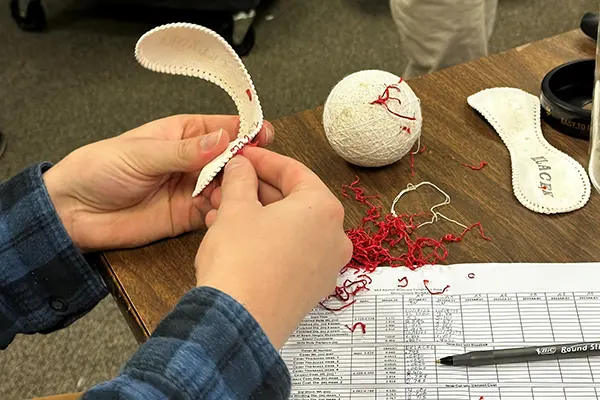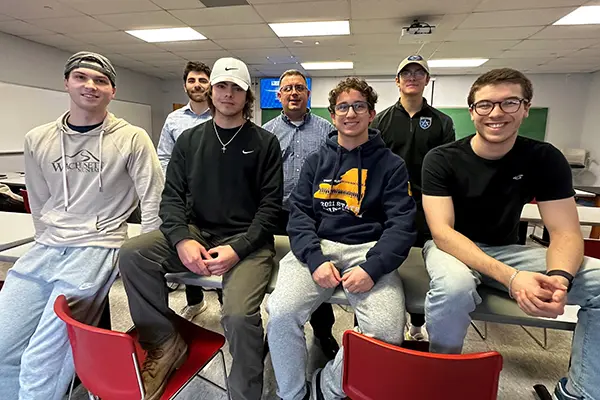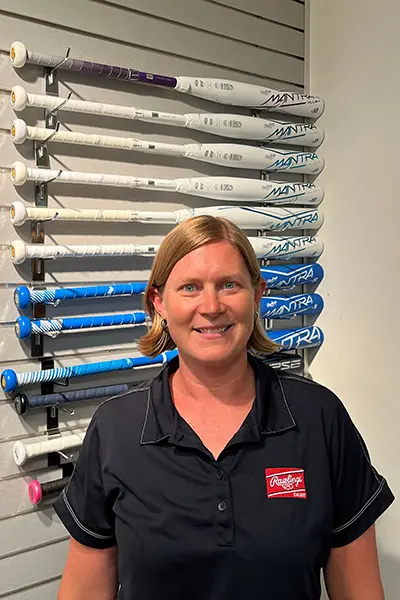UML Program is First for Undergrads in the U.S.
 Image by K. Webster
Image by K. Webster
02/13/2024
By Katharine Webster
The newest minor in the Francis College of Engineering – sports engineering – is hitting the sweet spot with students who love sports and also aspire to be engineers.
Gabriel Merrow, a first-year student from Bolton, Massachusetts, and a sprinter for the Division 1 men’s track and field team, says he was excited to learn that he could combine his major in civil engineering with his love of sports.
“Putting the two together would be great, especially working with professional athletes in any sport,” says Merrow, one of the first students to take Introduction to Sports Engineering, the initial course for the minor.
Those students are not only pioneers on campus, but they’re also the first students in the first integrated undergraduate program in sports engineering in the United States, according to the International Sports Engineering Association.
 Image by K. Webster
Image by K. Webster
The new minor builds on each student’s engineering major, and it will be expanded in the future to accommodate students in disciplines such as computer science and exercise science.
The minor was developed by Engineering Dean James Sherwood, director of UML’s Baseball Research Center and editor-in-chief of the Journal of Sports Engineering and Technology, and Patrick Drane ’00, ’03, the center’s assistant director and an executive committee member for the International Sports Engineering Association. The Baseball Research Center is the primary equipment testing lab for Major League Baseball.
“Because we have the baseball lab, we routinely get inquiries from high school kids and their parents asking if they can study sports engineering here,” Sherwood says. “This should draw people from all over the U.S. It’s also a good draw for Division 1 athletes.”
First-year Honors College student Joey Soly, a mechanical engineering major from Billerica, Massachusetts, who played varsity lacrosse at Shawsheen Valley Technical High School, says he chose UMass Lowell over another college after learning about the new minor.
“My dream was to become a professional athlete, but when I realized that wasn’t happening, my next dream was to go into engineering,” Soly says. “I’m not entirely sure where I want to go with it yet, but it sounds like fun.”
Of the half-dozen students in the first Introduction to Sports Engineering class, which is taught by Drane, all played sports in high school and three play intramural or club sports at UMass Lowell, while Merrow is a D1 athlete.
That led to a lively discussion in class after some of the students attended a campus talk by NHL Players’ Association Executive Director Marty Walsh, who briefly talked about the debate over whether pro hockey players should wear neck guards.
“I grew up playing hockey, and I saw someone at my brother’s game whose life was saved by a neck guard,” said Nick Castellino, a sophomore civil engineering major, during a class conversation about the roles that various materials, collective bargaining and safety testing would play in deciding whether neck guards would be allowed or required in the NHL.
After the introductory class, the minor offers six areas of focus that are based on a student’s major, their primary career interest or both. For example, someone majoring in chemical engineering or plastics engineering could choose to focus on sports materials, taking classes including Polymers in Sports. The other areas of focus are biomechanics, sports electronics, sports product design, sports engineering mechanics and sports infrastructure, such as physical facilities.
 Image by Courtesy
Image by Courtesy
“A student who really wants to get a job in sports engineering needs to be familiar with the social side – the business of sports, sports psychology, physiology and health, and politics, race and gender in sports,” Drane says.
As seniors, all students in the minor will either complete a sports-related capstone project within their major or take part in a hands-on industry, business or legal experience. The latter can include internships and co-ops. Interested students can also do research with faculty who study materials, biosensors, human performance, smart fabrics and more.
While the minor is new, many of the scores of UML students who have interned or worked as research assistants in the Baseball Research Center since it was founded in 1999 have gone on to work for sporting goods companies, including New Balance.
Becky O’Hara ’06, who worked as a graduate research assistant in the baseball lab while completing her master’s degree in mechanical engineering, was hired as a bat engineer by Rawlings Sporting Goods upon graduation. She is now director of research and development at the company, which sends baseball and softball bats, balls, helmets and other protective equipment to the baseball lab for testing.
O’Hara says that Rawlings and other companies in the sports equipment industry will be eager to hire engineering graduates who also have some understanding of business, data analytics and athletes.
“We’re developing products for athletes, so anything that helps our engineers better understand our customers and their needs is beneficial for us," she says.


